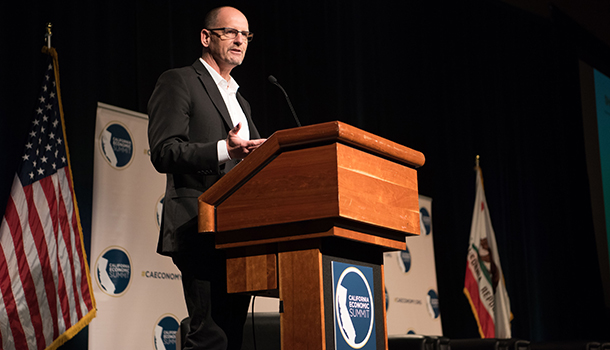
Attendees signing the Summit Principles for Shared Prosperity on Day Two of the Summit Sacramento (Photo Credit: John Guenther/CA Fwd)
The 2016 California Economic Summit concluded on Wednesday in Sacramento. More than 500 regional civic leaders from the public and private sectors attended to tackle solution to an issue that is fundamental to California’s future—how to lift millions of Californians out of poverty by improving workforce preparation, building more housing units and modernizing our crumbling infrastructure.
As living costs rise and more than one in four Californians continue to struggle to find pathways out of poverty, the Summit worked to put even more families on the road to shared prosperity. It will also give participants a unique opportunity to discuss how business executives, civic innovators and policy leaders can work together to promote a prosperous economy, a green and resilient environment, and thriving communities
To close out the two-day event with a call to action, Bill Mueller, chief executive of Valley Vision and co-chair of the Summit Steering Committee, eloquently summed up the key words shared by speakers of the day:
“Lt. Governor Gavin Newsom told us that, in a time of turbulence and opportunity, community colleges ought to be the elixir for much of what ails us.
University of California President Janet Napolitano said we cannot have a failure of imagination. We need to be thinking about the California of 2025 to make sure our education segments are prepared for that economy of tomorrow.
From an employer's perspective, PG&E's Dinyar Mistry said educators need to prepare students, not just with market-relevant competencies, but also to teach effective communication and problem-solving skills to get them ready for success.
Shannon Peloquin told us that McKinsey research shows the lack of affordable housing is not isolated to San Francisco or L.A. or to the less well off. It is pervasive, affecting 50 percent of middle income families in every single metro of California.
To underscore the urgency of the crisis, Senator Toni Atkins said housing is the platform for success in each one of the other areas of California, and there will be vigorous legislative action next year.
Sonoma County Supervisor James Gore reminded us of the importance of leveraging and learning — an indispensable outlook when putting together the complicated web of groundwater and integrated water management plans.
At lunch Bud Colligan and Sunne Wright McPeak showed us what steward leadership really looks like in practice — strength AND humility — drive AND accomplishment.
Doctor Raj Chetty of Stanford told us there's a 7.5 percent chance of achieving the American Dream and helped us understand some of the emerging patterns that underlying opportunity variances across the country, and in our communities.
Abby Davisson of the Gap told us how employers are showing the way, giving young people life skills and work experience because it is the right thing to do and it makes business sense. Her advice: tell stories!
Chad Mayes urged his fellow elected officials to tackle the tough issues, to use incentives, to mix it up, but work together to make people's lives better.
It is inspiring to have been around hundreds of leaders these past two days that represent the dreams and diversity of California — leaders who are committed to doing things differently.
To be audacious leaders who challenge the status quo and value teamwork. I believe, as thousands of others do, that teamwork is the only way we can unlock the tremendous energies of an entire country, a pioneering state and a set of a dynamic regions.
We are showing the country that democracy can work if we listen, learn, align, and work together. Let's make that our goal in 2017.”
For Day One coverage, read the wrap-up:
Challenges of housing, workforce and water take spotlight on Day One of 2016 Summit
For coverage of Day Two, read our two-part summary:
Reinforcing California’s higher education system for the future critical to workforce pipeline
Strong supply of housing and water key to upward mobility for workforce

